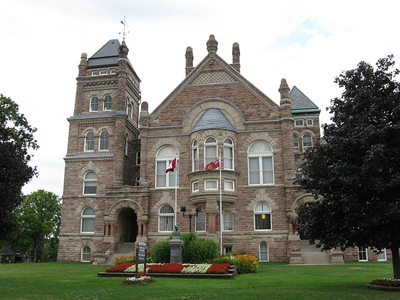CLN4U
Canadian and International Law
Unit 3: Rights and Freedoms
Activity 2: How has the protection of human rights changed over time?
Our justice system consists of a number of different components. These different parts work independently of one another yet they are interconnected.
Consider this scenario:

A man witnesses a woman place an item in her bag and leave the store without paying for the item. She was shoplifting. This is considered the offence of theft under the Criminal Code. The woman is later arrested because her actions were recorded on a security camera and the police used the statement of the witness to help identify the woman. The police investigate the theft, determine her identity and she is charged. The matter now goes to court. The woman goes before the judge and pleads “not guilty.” She has the help of a lawyer. The police officer and the witness go to trial to give evidence. The judge decides that she is guilty and that she should pay a fine and do community service. The judge warns her that she is to follow the law and complete the terms of the sentence or she could face time in prison.
Obviously this is a very straight forward example but it does show the connection between citizens, the law made by the government, the police, the courts and potentially, the prison system. Each part of the system is important to maintain a democratic legal system that upholds the rule of law. Additionally, each part of the system is responsible to uphold the rights and freedoms that are protected by law.
Rights of arrest: Is it just like television?
We have all grown up watching television police arrest somebody and then read them their “Miranda” rights but what is it, and more importantly how has Miranda folklore entered Canadian legal mythology? Canadian Constitutional rights and freedoms under the Charter are different from American rights under the U.S. Bill of Rights. In Canada it is more complicated, and the “arrest caution” varies from police force to police force and from province to province.

Under the Canadian Charter of Rights and Freedoms a person has the right;
- to be informed promptly of the reasons therefore;
- to retain and instruct counsel without delay and be informed of that right;
- to have the validity of the detention determined by way of habeas corpus and to be released if the detention is not lawful.
Canadian warnings do not use the phrase “right to remain silent” but that right is implied via s. 7 Charter Rights and the warning. Nearly every single criminal lawyer in Canada and the United States will advise a person arrested, detained, in custody, to keep their mouths closed and not to talk to police, remain silent, and only speak to their lawyer. The burden is on the person to remain silent. People should be aware that though these cautions may seem very similar they have been interpreted very differently by the courts.
Source: The Lighthouse Law Files
Consider the rights involved in the shoplifting scenario described above:
- There is a sign in the store that indicates video surveillance is in use as privacy is a right.
- The arresting officer would read the woman her legal rights.
- The woman is entitled to a lawyer to help to defend herself.
- The judge must ensure the woman understands the charges against her and understands the proceedings. She may need a translator for example.
Individual citizens, government, police, courts and prisons all have a responsibility to protect and uphold rights.
Look at the image below. Click on each of the pillars to read about the roles and responsibilities of each.
Let’s take a moment to focus upon the responsibilities of individual citizens. Most Canadians have little difficulty identifying their rights. Sometimes however, Canadians forget that in order for our rights to be fully realized, we also have responsibilities or an obligation to uphold these rights.
Can you make a list of the responsibilities of Canadians using the following pictures as a guide. Once you have created your list, click on each image to compare your list, then test yourself by taking the quiz.
Watch this quick video on Rights and Responsibilities.
These responsibilities extend beyond our everyday lives to the workplace. Have a quick peek at the learning object below. Try your hand at the quick quiz. Can you see the connection between the actions in the workplace and the protection of the rights and freedoms of all people?
Do we take our rights for granted?
As Canadians we know we have rights, and we know that we have responsibilities. What happens when we do not exercise our rights or fulfill our obligations? Study the infographic below published by the National Post on July 5th, 2011.

 Explanation Game
Explanation Game
Let’s try to understand these findings from Statistics Canada. Use the following sentence starters to consider these findings.
First focus upon identifying something interesting about the graph:
"I notice that..."
Follow that observation with the question:
"Why is it that way?" or "Why did it happen that way?"
Try to explain your thinking:
“What makes you think that?”
Try to expand your thinking to make connections:
“What action do you think can be taken by individuals, groups or government to improve voter turnout?”
“What do you think might be the consequences for individuals, the community or the government if people fail to participate in the democratic process?”
Try to draw a conclusion:
“Do you think this is a right Canadians take for granted or a responsibility that is overlooked?”

By User: K.lee (Own work) GFDL, CC-BY-SA-3.0
or CC BY 2.5, via Wikimedia Commons
Over time, the rights and freedoms enjoyed by those who live in Canada have become more clearly articulated through both the creation of new laws and through court decisions. You know that new law can be introduced through legislation; elected Members of Parliament and Members of Provincial Parliament, craft bills based on the perceived needs of the society. One relatively recent example might include texting and driving legislation.
New laws can be also created through court decisions or precedents. Generally speaking, the judge might apply the law in a new way to respond to the specific circumstances of a case or to clarify a legal concept or principle. These landmark cases might also establish a “test” which would guide decisions in future cases that are similar. An example of a legal precedent might be the decision by the Supreme Court in the case of R. v. Sparrow that Aboriginal Rights that predate the Constitution Act, 1982 cannot be infringed without justification.

By Balcer (Own work) [Public domain], via Wikimedia Commons
The operation of the doctrine of stare decisis is best explained by reference to the English translation of the Latin phrase. “Stare decisis” literally translates as “to stand by decided matters.” The phrase “stare decisis” is itself an abbreviation of the Latin phrase “stare decisis et non quieta movere” which translates as “to stand by decisions and not to disturb settled matters. Basically, under the doctrine of stare decisis, the decision of a higher court within the same provincial jurisdiction acts as binding authority on a lower court within that same jurisdiction.”
Source: Paul, Perell M. “Stare decisis and techniques of legal reasoning and legal argument.” The Canadian Legal Research and Writing Guide. 1987.
Changes in human rights law are always controversial; sometimes those in power feel threatened. Sometimes violence accompanies the efforts to affect change and sometimes ideologies or worldviews conflict. Different individuals and groups can view a situation very differently.
Let’s take some time to look at a few changes.
Did you choose to extend your learning?
As you were working through the timeline, how many times did you take the opportunity provided to extend your learning? It is completely “normal” that not all of the options would appeal to you. You may also have found yourself under stress or pressed for time at the present. You may have chosen to look at some, but not all. However, if you are frequently or always disinterested, stressed or overextended, it may be time to pause and reflect upon the circumstances that are causing the problem.
If you have a minute, watch the Ted Talk "How to stay calm when you know you'll be stressed," by Daniel Levitin. Notice the importance of the critical thinking process: asking questions, seeking evidence, analysing and re-evaluating information and drawing conclusions.
Having read through the details of the timeline, you will likely have noticed the many factors that influenced the legal changes. In some cases, the change developed from a specific interest or desire to improve human rights as the belief in equality and democratic freedom became a more widespread belief.
You also likely noticed the influence of politics, world events, historical realities and conflicting worldviews such as colonialism, racism and eurocentrism. Our world continues to change and these influences, and others, will continue to impact future legislation.
Click on the following pictures to see all of the different factors that influence legal change.
What forces do you think will have an impact on future rights legislation?
Please take a minute to listen to the former President of Ireland Mary Robinson as she considers why climate change is a threat to human rights.
Think about the ideas that Mary Robinson has presented. What does she mean by “No one left behind”?
Let’s summarize what we heard in this video. Click through the slideshow below.
This means the right to govern in a specific territory.